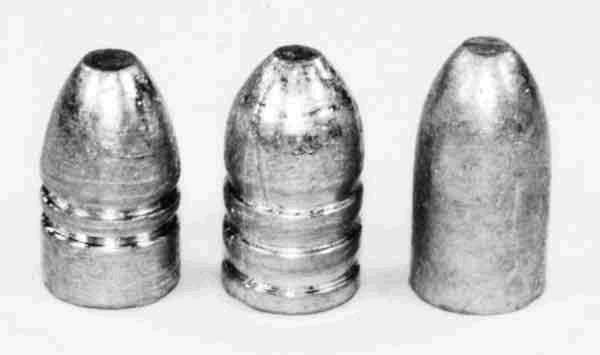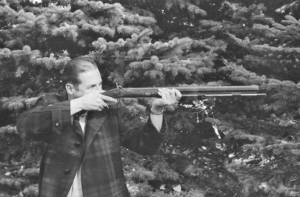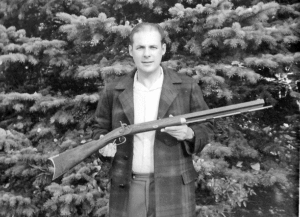The date was the 5th of November, 1854 . It was a foggy, dank day in the Crimea , perfect for surprise and ambush. The Russians took quick advantage of it, throwing their weight against an ill-prepared line of British troops in the Battle of Inkerman. Forty-two thousand Russian attackers swept down against half that many British troops; yet the British triumphed, losing far fewer troops than the Russian’s 20,000 and driving the attacking Russians from the field.
The major reason for the surprising performance of the British troops was their use of the then new rifled musket, the primitive British model of 1851. It offered such an advantage over the common smoothbore musket that battles fought at a great disadvantage could be won. The rifled musket could be loaded as quickly as the common smoothbore, yet was accurate at much longer distances.
The bullet the British used so effectively was originally developed in about 1840 by the Frenchman Delvigny, who discovered that a short slip-fit bullet with a hollow-base and a base-plug would load quickly in a rifled firearm yet be reasonably accurate. Rifled arms had been known since the 1500’s, but were slow to load, which limited their military effectiveness. By 1846, another Frenchman, Etienne Minie, had refined the bullet by elongating it, adding grease bearing channelures, and inserting an iron cup into its base instead of as plug. James H. Burton, assistant master armoror at Harper’s Ferry Arsenal, developed a similar bullet at about the same time, but without the iron cup, the thin sides of the hollow base gripping the rifling when fired. . The famed English gunmaker Pritchett developed a smoothsided bullet with hollow base, with boxwood base-plug and ogival nose.
[one_third] [/one_third] [one_half_last]From left to right: Burton’s 460 grain Bullet of Civil War fame, Lymans newer 505 Gain Minie, Pritchett’s smooth sided 550 grain bullet. Many shooters not only lubricate the grooves but also fill the hollow base with grease. I find this practice destructive to accuracy.[/one_half_last]
[/one_third] [one_half_last]From left to right: Burton’s 460 grain Bullet of Civil War fame, Lymans newer 505 Gain Minie, Pritchett’s smooth sided 550 grain bullet. Many shooters not only lubricate the grooves but also fill the hollow base with grease. I find this practice destructive to accuracy.[/one_half_last]
Of these astute designers, only the name of Minie is remembered. and all hollow-based bullets of whose-ever design are currently referred to as Minie Balls. The hollow based bullet we use, and that was used in Our Civil War, was really Burton ’s Bullet, but things French were much in style then, so only Minie’s name is remembered.
The bullet the British used so effectively
was developed in about 1840 by Delvigny-
Etienne Minie-refined the bullet,-James Burton
developed a similar bullet,-Pritchett developed
a smoothsided bullet with hollow base-But only
the name of Minie is remembered.
The new bullet and rifled musket met their real test in the American Civil War. Aimed fire from this weapon was responsible for killing or wounding more than 639,000 men vs. only another 71,000 killed or wounded by all other means.
The rifled muskets that saw action in the American Civil War were highly developed and skillfully manufactured weapons of the highest quality. Calibers had been reduced to .58, firing a bullet of nominally 460 grains weight at about 1100 ft. sec. with usually 60 grains of ffg black powder. Tapered three groove rifling was utilized, and manufacturing techniques were standardized.
The soldier armed with a rifled musket was not only expected to reload just as fast as his predecessor with the common smoothbore musket, but was also expected to AIM and HIT the target, something that he had never been called upon to do before.
[one_half] [/one_half][one_half_last]This is my favorite of the rifled muskets- the famous ‘Mississippi’, originally used by Jefferson Davis Mississippi troops in the Mexican War. It was used with round ball then, but was adapted for use with 54 or re-bored to 58 for Minie Ball during the Civil War. This particular rifle is by Euroarms in 54 caliber with a 1-60 twist. It shoots either 54 Minie or 530 round ball and patch quite well.
[/one_half][one_half_last]This is my favorite of the rifled muskets- the famous ‘Mississippi’, originally used by Jefferson Davis Mississippi troops in the Mexican War. It was used with round ball then, but was adapted for use with 54 or re-bored to 58 for Minie Ball during the Civil War. This particular rifle is by Euroarms in 54 caliber with a 1-60 twist. It shoots either 54 Minie or 530 round ball and patch quite well.
[/one_half_last]
Just as the rifled musket revolutionized warfare, so too would it have revolutionized the hunting sports following the Civil War if cartridges had not been developed. Even then, the effect of the rifled musket was felt in the Western United States . It was used for a few years after the War as the infantry issue arm, and was sold as surplus to thousands of settlers and pioneers who needed an inexpensive yet powerful arm for their trip to the west.
Even the Hawken brother’s famous plains rifle would have eventually been converted to fire a hollow-based bullet, as few western hunters whose lives depended on their weapons would stand in the way of such progress. Proof of this was the discovery of a 58 cal. barrel and bullets by a young sheepherder in Utah ‘s High Uintah Mountains before WWI. The barrel served for years as a barn door prop but the bullets were carefully stored.
This man, now in his dotage, brought the barrel, lock and bullets into my office in the 1980’s. He related that he spent his summers as a youth herding sheep in the high Uintah Mountains north of Vernal, Utah . One day he was kicking around in the sagebrush at the foot of a shale slide when he spotted the rusty barrel, a percussion lock, a pile of grayish corroded bullets and a brass buttplate. There was no stock and he didn’t think to search for a trigger guard.
Just as the rifled musket revolutionized
warfare, so too could it have revolutionized
the hunting sports following the Civil War
if cartridges had not been developed.
When I saw the parts in 1980 the bullets proved to be heavily corroded lead Minie Balls of the original Civil War pattern. And they fit the about 30 inch octagon barrel with drum and beat up nipple quite well. A check with a ramrod, something the old man had never thought to do showed that the breech was full of something. An x-ray showed that it was loaded with a Minie ball.. The lock was a Goulcher, sure enough with the hammer rusted in at full cock. Obviously, someone had been surprised by something dangerous and disagreeable and lost the rifle before he could use it. Probably not an Indian, because the brave would have taken the rifle . Probably something with teeth and claws. It makes one wonder what story those old parts could tell.
For much of the hunting we do, a rifle firing a Minie Ball can be extremely effective. Murray Stowe, from Salt Lake City, likes his Remington Zouave repro with Lyman’s modern 505 gr. Minie over 70 grains ffg Black powder. He’s used to it to kill three mule deer on hunts in Utah ‘s Uintah Basin . His most notable shot was taken at 175 yards. Despite the distance, the big Minie went completely through the deer’s chest for a clean kill.
Deep penetration is not unusual because of the superior sectional density and the heavy weight of the Minie. Dean Reynolds, from Vernal, Utah , used a Navy arms musket and Minie Ball in front of 90 grains ffg on a 5 point elk. The bull was running away from him so he held for the root of the spine. The range was just less than 150 yards. The Minie struck just above the elk’s tail and ranged forward along the dorsal spines then struck the base of the neck for an instant kill. The length of a elk’s back is somewhat close to five feet, so that is quite some penetration.
The .58 caliber Minie is by far the most commonly used although molds for Minie’s are available in .54, .50 and .45 calibers from either Lee or Lyman. The classic Minie is Lyman’s # 575213, which approximates the shape and weight of the original American Minie bullet designed by James Burton. It weighs approximately 460 grains.
However, a great favorite for light target shooting and plinking has long been the 575213-OS, alas, no longer available from Lyman. It casted a few thousandths oversize, which allowed the shooter to custom lube and size it for a better fit in a favorite musket. The technique is to size the Minie so that it fits the bore less a thousandth of an inch. That bullet will shoot consistently into 4 inches at 100 yards with iron sights from a good musket.
The long time favorite Minie for heavy hunting loads is Lyman’s #575612, which is designed with thick, heavy base skirting. This bullet is very accurate in heavy barreled hunting rifles capable of safely digesting larger charges of black powder than will the common rifled musket with it’s relatively thin walled barrel. The heavier base skirting is necessary because the thinner skirts of the original Minie fold forward around the base of the bullet if the gas velocity at the muzzle is high enough. And this just blows your group.
The American Springfield and Zouave rifles are shallowly rifled with three equal lands and grooves. The grooves are deeper at the breech than at the muzzle with a twist of 1 in 60 inches. Despite the fine accuracy demonstrated by this arm, better accuracy is attributed to the original British Enfield and to it’s reproductions. This rifle has a twist of 1 in 48 inches with five lands and grooves and the characteristic tapered rifling.
Rebarreling an old musket is easy. One can use a variety of modern made barrels with a variety of rifling shapes and all perform decently. The 1-48 twist in custom rifles with cut or swedged grooves no more than .006 deep at the breech seems to be the best combination.
A favorite Minie for heavy hunting loads
is Lyman’s #575612 which was designed with
heavy base skirting. -this bullet (is)
accurate in heavy barreled hunting rifles-
The best method of carrying and dispensing a Minie Ball in the hunting field is to use techniques similar to those developed by the military in the 1850’s. Reproductions of the original leather pouches used for holding Minie Ball cartridges are still readily available from muzzleloading supply houses. These are meant to hold the paper cartridges of the time, with Black powder and prelubricated Minie Ball. Paper cartridges are easy to make but are not waterproof. Still, they are very useful.
A variety of manufacturers make plastic cartridges with water resistant cavities for bullet and powder, like the WHITE QuickCharger. Some even sport a cap dispensing devise and short starter built in. The simple kind can be carried in the shotshell loops on belt or bibs or best on the rifle stock where they are plenty handy. They should also be ‘see through’ so you can tell when they are loaded just by looking and hold the Minie tightly by friction alone. Why have to pry off a cap to get at a bullet when it can pushed through the QuickCharger with ramrod alone.
Loading a musket with a QuickCharger is simple. Just pop off the cap on the QuickCharger and pour the premeasured powder charge down the barrel. Place the bullet end of the device over the muzzle. The Minie was previously inserted nose first into the QuickCharger.
Use the ramrod to push the Minie base first into the muzzle, following which the bullet is rammed all the way down.. and the nipple capped. The whole operation can’t take much more than fifteen seconds.
The lubricant used in the War between the States was two thirds tallow and one third beeswax. This formula fouls badly after only a few shots. Many modern shooters use Crisco when the weather isn’t too hot or one of the new natural non-petroleum lubes that have sprung up in the last few years. Ox-yoke marketed the original, followed close on by Thompson Center and Hodgen. All of these are soft and gooey, different only in color and smell. White’s blue Superlube is similar but a lot firmer and stays on the bullet better, especially in hot weather. All are especially effective with Pyrodex.
One fortunate thing about the rifled musket is that a considerable number of originals still exist. Some are still accurate despite 140 years of continual use or storage in attics. Just be sure the one you shoot is in excellent condition. For safety’s sake, don’t bother with the rusty barreled ones. If the barrel is too poor to shoot successfully either hang it up or have it rebarreled by a competent muzzleloading gunsmith. (Be sure to save the original barrel.)
Keep in mind that the tighter the bullet, the more accurate the shot, up to a certain point. Most Minie’s are 2-4 thousandths of an inch smaller than the barrel land to land diameter. This guarantees easy slip fit loading, especially of you are in a battle and are firing lots of shots. In the hunting situation, where only a shot or three will be taken on any given day, and with the newer substitutes for black powder, which leave a lot less grit in the barrel after a shot, you can size up your Minie ball to fit the lands less a thousandth only. This will produce excellent accuracy, in most originals and reproductions of less than 4 inches at 100 yards with open sights, with easy reloading for the few shots you are going to fire.
 This musket capper will hold a dozen musket caps and can be slung around your neck on a thong. It’s a good way to speed up your second shot.
This musket capper will hold a dozen musket caps and can be slung around your neck on a thong. It’s a good way to speed up your second shot.
Originals rifled muskets in excellent shooting condition are right expensive. Fortunately, there are a large number of excellent replicas available. The popularity of the Civil War and North South Skirmish Association re-enactments have assured us of that. The most common is the handsome brass mounted Zouave rifle, originally made by Remington and currently imported from Italy by many importers. Another good looking replica, and my personal favorite, is the Mississippi Rifle, originally a 54 cal rifle meant for round ball or .54 Minie but with the large majority later re-rifled for 58 Minie. These brass finished replicas are imported by Navy Arms and others. Several models of the Springfield rifled musket are also available and the Enfield musket is still being imported, just as in Civil War days.
If you want a custom hunting rifle, heavy octagon barrels meant for huge charges can be purchased from various custom gun barrel makers. These can be very effective hunting arms although the charges needed for higher velocities with Minie Balls are immense and brutalize the shooter.
I once used a custom Minie-shooting heavy barreled hunting rifle on moose in British Columbia the best hinting rifle I had designed up too that time. I loaded 160 grains of ffg Black powder for velocities of approximately 1350 FPS with the 550 grain Prichett bullet, which has a BC of about 25. Despite the big powder charge, the bullet fell like a rock. I had sighted in the rifle at 100 yards, which would put the big bullet 15 inches low at 150 yards
Here I am with what I thought was the best hunting rifle in the world at the time. I had not yet designed the fabulous Super 91 or the long SuperSlug that went with it.
When a nice 50 inch moose was spotted about 150 yards away, standing broadside, I sat down and took a careful shot, figuring that the big animal was only 100 yards off. The moose didn’t even flinch and the Indian guide said, “shoot under him, try again.” I knew darn well the moose was center shot, but quickly reloaded and put another bullet downrange using the same sight picture. The moose ran off. The Indian said, “Hey Doc, you damn fine shot. Hit same place twice.” Accuracy is not the problem, but range estimation and knowing your bullet’s potential path sure is.
There are a large number of excellent
replicas available. The popularity of
the Civil War and North South Skirmish
Association re-enactments have assured us of
(a good supply).
Later I popped a somewhat smaller moose, but only after considerable practice back at camp. The Minie showed good penetration and expansion and the moose went down after only a few steps. My mistake was the size of the moose, he was so big that he looked far closer than he really was.
The lesson is that the hunter needs to know his rifle and shoot it a lot before he tries it on precious game. There’s another lesson. That big Minie Ball was very effective once it got into the moose. He didn’t go far at all, like 30 feet.
You can use your trusty rifled musket for effective muzzleloading hunting. Just get familiar with it, practice a lot and watch your range closely. Get to know it and its rainbow-like trajectory. You won’t be disappointed.
GOOD HUNTING
DOC


